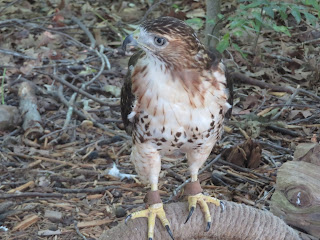 |
| Swimming area along Kentucky Lake |
 |
| Double pen house from the 1850s |
Manned primarily by volunteers, the Homeplace 1850s Working Farm and Living History Museum were a glance back at a two-generation, middle-class family farm. Dressed in clothing from the era, the volunteers provided a wealth of information about what life would have been like as we moved through the restored historic structures.
Woodland Nature Station is home to a myriad of wild animals who have been injured or orphaned and are not able to survive on their own, ranging from a coyote to multiple owl species. The Backyard Habitat and Gardens at the Station are planted with native plants, resilient to the heat and cold experienced in this region. Dozens of hummingbirds were taking advantage of the feeders set up in the gardens.
Woodland Nature Station is home to a myriad of wild animals who have been injured or orphaned and are not able to survive on their own, ranging from a coyote to multiple owl species. The Backyard Habitat and Gardens at the Station are planted with native plants, resilient to the heat and cold experienced in this region. Dozens of hummingbirds were taking advantage of the feeders set up in the gardens.
Open dawn to dusk, the Elk and Bison Prairie offers the opportunity for visitors to see these magnificent animals. Historically, vast herds had roamed these lands but were hunted nearly out of existence. Through a two-decades-long project, the animals were reintroduced and the grounds opened to the public in 1996. Near sunrise and sunset are the recommended times for success in sighting the animals, especially during the hot summer months when they want to hide in the shade.
Intrigued by the frequent signs for cemeteries along the main road, it turns out that there are 271 cemeteries within the park. The earliest recorded burial took place in 1811. The USDA Forestry Service maintains the access roads to the gravesites but maintenance of the cemeteries is left to volunteer groups or in some cases to the remaining, dwindling family members. Over 200 of the cemeteries are small family plots, many containing the graves of infants and children from a time when mortality rates for the young were high. The graves also reflected the deaths of young women, presumably dying due to childbirth complications, and for the many youthful men killed in wars or as a result of the violent times in which they lived.
We’ve enjoyed our visit here, but we are now heading on to Illinois.







No comments:
Post a Comment